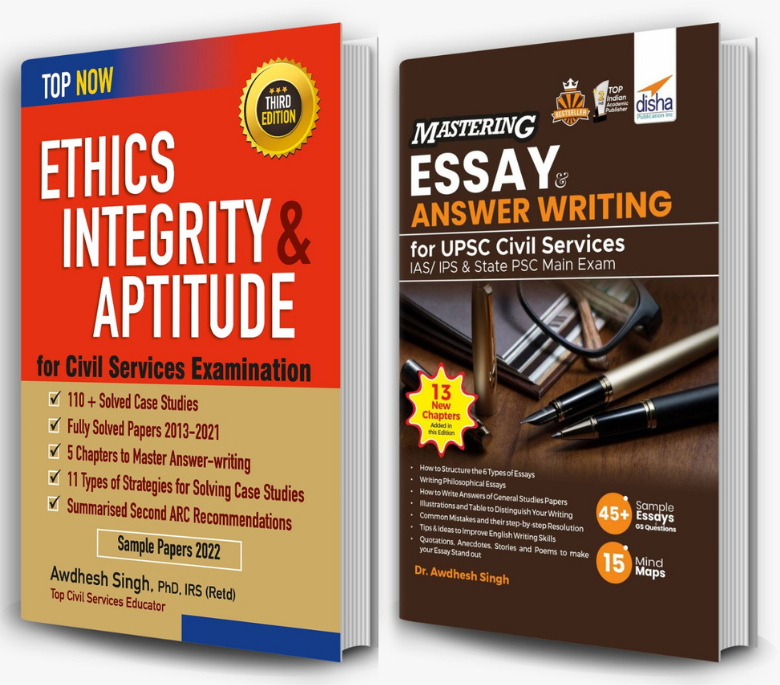Essay and Answer Writing → Model Essays
Topics
All
Civil Services in India (26)
Ethics, Integrity and Aptitude
» Chapters from Book (11)
» Case Studies (8)
Solved Ethics Papers
» CSE - 2013 (18)
» CSE - 2014 (19)
» CSE - 2015 (17)
» CSE - 2016 (18)
» CSE - 2017 (19)
» CSE - 2018 (19)
» CSE - 2019 (19)
» CSE - 2020 (19)
» CSE - 2021 (19)
» CSE -2022 (17)
» CSE-2023 (17)
Essay and Answer Writing
» Quotes (34)
» Moral Stories (18)
» Anecdotes (11)
» Beautiful Poems (10)
» Chapters from Book (5)
» UPSC Essays (40)
» Model Essays (38)
» Research and Studies (4)
Economics (NCERT) Notes
» Class IX (14)
» Class X (16)
» Class XI (55)
» Class XII (53)
Economics Current (51)
International Affairs (20)
Polity and Governance (61)
Misc (77)
Select Topic »

Civil Services in India (26)
Ethics, Integrity and Aptitude (-)
» Chapters from Book (11)
» Case Studies (8)
Solved Ethics Papers (-)
» CSE - 2013 (18)
» CSE - 2014 (19)
» CSE - 2015 (17)
» CSE - 2016 (18)
» CSE - 2017 (19)
» CSE - 2018 (19)
» CSE - 2019 (19)
» CSE - 2020 (19)
» CSE - 2021 (19)
» CSE -2022 (17)
» CSE-2023 (17)
Essay and Answer Writing (-)
» Quotes (34)
» Moral Stories (18)
» Anecdotes (11)
» Beautiful Poems (10)
» Chapters from Book (5)
» UPSC Essays (40)
» Model Essays (38)
» Research and Studies (4)
Economics (NCERT) Notes (-)
» Class IX (14)
» Class X (16)
» Class XI (55)
» Class XII (53)
Economics Current (51)
International Affairs (20)
Polity and Governance (61)
Misc (77)

Model Citizen Charter for Panchayats, 2021
In June 2021, Ministry of Panchayati Raj in collaboration with National Institute of Rural Development and Panchayati Raj (NIRDPR) released a Model Panchayat Citizens Charter framework for delivery of the services across the sectors, aligning its actions with Sustainable Development Goals (SDGs). Through a time bound manner, Panchayats were expected to utilise this framework to draw up a citizen’s charter and adopt it through a resolution of the Gram Sabha by 15 August 2021.
Recent News
Ministry of Panchayati Raj (MoPR) in collaboration with National Institute of Rural Development and Panchayati Raj (NIRDPR) released a Model Panchayat Citizens Charter framework in June 2021.
The event was virtually joined by all States/UTs – CM of Rajasthan, State Panchayati Raj Ministers from Assam, Bihar, Chhattisgarh, Haryana, Himachal Pradesh, Karnataka, Madhya Pradesh, Sikkim, Tamil Nadu, Uttarakhand, Uttar Pradesh and West Bengal, Panchayati Raj Secretaries & State officials and officials from Other Ministries viz. Ministry of Rural Development, Department of Drinking Water & Sanitation, Ministry of Jal Shakti, Ministry of Skill Development & Entrepreneurship, Ministry of Social Justice & Empowerment, Ministry of Education, Ministry of Health & Family Welfare.
What’s a citizen’s charter? Why is it needed?
A Citizens’ Charter is a tool to achieve good governance. Successful implementation of Citizens’ Charter improves service delivery, brings responsiveness on the part of Panchayat functionaries and enhances Citizens’ satisfaction. The concept was first articulated and implemented in the United Kingdom by the Conservative Government of John Major in 1991 as a national Programme. Citizen’s charters are not legally enforceable documents. They are just guidelines to enhance service delivery to citizens.
In India, the concept of citizen’s charter was first adopted at a ‘Conference of Chief Ministers of various States and Union Territories’ held in May 1997. A outcome of the conference was a decision to formulate Citizen’s Charters by the central and state governments, beginning with large public undertakings like the railways, telecom, posts, Public Distribution System, etc.
·A citizen’s charter is a response to the quest for solving the problems which a citizen encounters, day in and day out, while dealing with the organisations providing public services.
·The concept of Citizens’ Charter enshrines the trust between the service provider and its users.
·Six principles of the Citizens Charter movement as originally framed, were:
i.Quality: Improving the quality of services
ii.Choice : Wherever possible
iii.Standards : Specify what to expect and how to act if standards are not met;
iv.Value: For the taxpayers money
v.Accountability : Individuals and Organisations
vi.Transparency: Rules/ Procedures/ Schemes/Grievances.
Model Panchayat Citizens Charter, 2021
Panchayats have been playing a critical role in preventing and managing the crisis of COVID-19 at the grassroots level. The aim of establishing a Citizen charter is to provide services to the people in a time bound manner, redressing their grievances and improving their lives. This will help in making the citizens aware of their rights on the one hand, and to make the Panchayats and their elected representatives directly accountable to the people.
The basic objective of ‘Gram Panchayat Citizens’ Charter:
·To empower the citizens in relation to public services and improve service quality on the lines of citizens expectations.
·For creation of Charter brings professionalism in Panchayat functioning and helps to reach out to all sections of community without any discrimination.
·Provide useful yardsticks for monitoring and evaluation of service delivery.
·The Citizens’ Charter is to be formulated by each Panchayat separately.
·Panchayats to discuss the various services provided to the citizens, the conditions citizens shall have to fulfil for getting a service and the time limit of each service.
·It should seek the views of the Panchayat Secretary and other officers of the concerned line departments.
·The charter should include only those services that are delivered by the Panchayat on a regular basis.
·It should include information on following:
i.Vision and Mission: ultimate direction in which the Panchayat seeks to move.
ii.Service Standards/Procedure for obtaining services: eligible citizen shall apply to the designated officer along with the essential documents and also pay the prescribed fee if any.
iii.Grievance redressal: The Sarpanch and the Panchayat Secretary must be accessible to listen to the grievances and make arrangements to address the complaint effectively.
·Timely redressal of Citizens grievances not only reduces discontent, but also helps Panchayat to improve its functioning.
Significance
·A citizen’s charter, with clearly outlined principles to assist citizen’s in day to day activities improves governance.
·Services will be provided in a timely and time bound manner.
·Grievances will be tackled and addressed efficiently.
·It is a step towards transparent, accountable and responsive governance.
Challenges
·In most cases, the charter, written in erudite language, remains inaccessible to people at grassroots.
·Only a small number of people remain aware of such rules and charters.
·Officials are often found indifferent to people’s issues and show lack of sympathy.
·Rampant corruption at Panchayati levels.
·Lack of trained staff and accountability.
·The charter has not been adopted by all states
·Charters are not legally binding documents and hence implementation is not done strictly.
Way Forward
Exemplary implementation of the Charter in a major public interface area of government would not only establish the new concept of bureaucracy but also act as a role model for replication in other sectors/areas. Some considerations can make it even more effective:
·The Charter should be made available in local languages so that more people are aware
·The staff responsible for redressal should be trained efficiently
·Improved infrastructure at villages
·Clarity regarding the processes and standards
·Use of upgraded technology for better implementation
Sources:
PIB
Panchayat.gov.in
Ndmc.co.in

Looking for a One-stop Solution to prepare for ‘Ethics, Integrity, and Aptitude’ and ‘Essay and Answer Writing’ for UPSC?
Buy Dr. Awdhesh Singh’s books from the links below-
Buy Dr. Awdhesh Singh’s books from the links below-
Ethics, Integrity & Aptitude for Civil Services Examination
Amazon - https://amzn.to/3s1Qz7v
Flipkart - https://bit.ly/358N2uY
Mastering Essay & Answer Writing for UPSC Civil Services
Amazon - https://amzn.to/3JELE2h
Flipkart - https://bit.ly/3gVIwmv
| Related Articles |
| Recent Articles |
